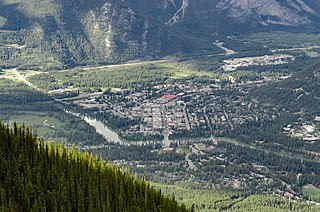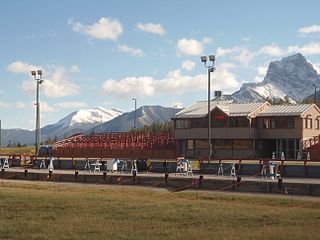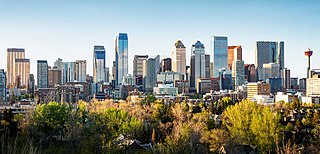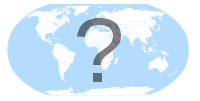
The 1988 Winter Olympics, officially known as the XV Olympic Winter Games and commonly known as Calgary 1988, were a multi-sport event held from February 13 to 28, 1988, with Calgary, Alberta as the main host city. This marks the most recent time that two consecutive Olympic Games were hosted in North America. It was the first Winter Olympic Games to be held for 15 days, like the counterpart Summer Olympic Games. The majority of the events took place in Calgary itself. However, the snow events were shared by Nakiska ski resort in Kananaskis Country at the west of the city and the Canmore Nordic Centre Provincial Park in the town of Canmore.

Banff National Park is Canada's first national park, established in 1885 as Rocky Mountains Park. Located in Alberta's Rocky Mountains, 110–180 kilometres (68–112 mi) west of Calgary, Banff encompasses 6,641 square kilometres (2,564 sq mi) of mountainous terrain, with many glaciers and ice fields, dense coniferous forest, and alpine landscapes. Provincial forests and Yoho National Park are neighbours to the west, while Kootenay National Park is located to the south and Kananaskis Country to the southeast. The main commercial centre of the park is the town of Banff, in the Bow River valley.

Banff is a resort town in Banff National Park, Alberta, Canada, in Alberta's Rockies along the Trans-Canada Highway, 126 km (78 mi) west of Calgary, 58 km (36 mi) east of Lake Louise, and 1,400 to 1,630 m above sea level.

The Olympic Oval in Calgary, Alberta, Canada, is North America's first covered speed skating oval; it was built for the 1988 Winter Olympics and opened 38 years ago on September 27, 1987. Located on the University of Calgary campus, it is the official designated training centre for Speed Skating Canada and the Elite Athlete Pathway. This oval includes a hockey rink, a short track speed skating rink, a 400m long track rink and a 450 m running track.

The Bow River is a river in Alberta, Canada. It begins within the Canadian Rocky Mountains and winds through the Alberta foothills onto the prairies, where it meets the Oldman River, the two then forming the South Saskatchewan River. These waters ultimately flow through the Nelson River into Hudson Bay. The Bow River runs through the city of Calgary, taking in the Elbow River at the historic site of Fort Calgary near downtown. The Bow River pathway, developed along the river's banks, is considered a part of Calgary's self-image.
Highway 1 is a major east–west highway in southern Alberta that forms the southern mainline of the Trans-Canada Highway. It runs from the British Columbia border near Lake Louise through Calgary to the Saskatchewan border east of Medicine Hat. It continues as Highway 1 into both provinces. It spans approximately 534 km (332 mi) from Alberta's border with British Columbia in the west to its border with Saskatchewan in the east. Highway 1 is designated as a core route in Canada's National Highway System and is a core part of the developing Alberta Freeway Network.

Calgary, Alberta, Canada, is home to a deep-seated tradition of winter sports. Much of this stems from its location, with proximity to the Alberta Rocky Mountains and Banff National Park. After hosting the 1988 Winter Olympics, the city has also had winter sports and training facilities. Beyond winter sports, Calgary has several professional and amateur sports teams and is a major world pro rodeo center, with the city's Stampede Park holding the annual Calgary Stampede.

Mt. Norquay is a mountain and ski resort in Banff National Park, Canada, that lies directly northwest of the Town of Banff. The regular ski season starts early December and ends mid-April. Mount Norquay is one of three major ski resorts located in the Banff National Park.

Alberta has been a tourist destination since the early days of the 20th Century, with attractions including national parks, National Historic Sites of Canada, urban arts and cultural facilities, outdoor locales for skiing, hiking and camping, shopping locales such as West Edmonton Mall, outdoor festivals, professional athletic events, international sporting competitions such as the Commonwealth Games and Olympic Winter Games, as well as more eclectic attractions.

Spray Valley Provincial Park is a provincial park located east of the Rocky Mountains, along the Spray River in western Alberta, Canada.
Cory Morgan is a Canadian blogger, Alberta independence politician and activist, and columnist for the Western Standard. He was one of the founders of the Alberta Independence Party in 2000. He was also a founding member of the Wildrose Party.

Patterson Heights is a residential neighbourhood in the southwest quadrant of Calgary, Alberta. It is bounded by Sarcee Trail to the east and north, Bow Trail to the south, 69 Street to the west and Old Banff Coach Road to the south. Edworthy Park, developed in the Bow River valley, borders the community to the north and east across Sarcee Trail.
Canadian Olympics can mean:

Canmore Nordic Centre Provincial Park is a provincial park in Alberta, Canada, located immediately west of Canmore, 105 km (65 mi) west of Calgary.

Calgary is the largest city in the Canadian province of Alberta. It is the largest metro area within the three prairie provinces. As of 2021, the city proper had a population of 1,306,784 and a metropolitan population of 1,680,000 making it the third-largest city and fifth-largest metropolitan area in Canada.

The Calgary Olympic Development Association (CODA), operating as WinSport, is a non-profit organization based in Calgary, Alberta, Canada whose mandate is to provide training and development to Canada's Olympic athletes, and to maintain the facilities built for the 1988 Winter Olympics. The organization was founded in 1956 to bring the Olympics to Calgary, succeeding in its fourth attempt. WinSport has been credited with dramatically improving Canada's performance at the Olympics, as medal totals have increased at each subsequent Winter Games held since 1988, to a peak of 26 in the 2010 Winter Olympics.

The selection process for the 1988 Winter Olympics consisted of three bids, and saw Calgary, Alberta, Canada, be selected ahead of Falun, Sweden, and Cortina d'Ampezzo, Italy. The selection was made at the 84th International Olympic Committee (IOC) Session in Baden-Baden, West Germany, on 30 September 1981.

Mount Shark is a 2,786-metre (9,140-foot) mountain summit located in the Spray Valley of Kananaskis Country at the northern tip of the Spray Mountains range. It is situated on the southern boundary of Banff National Park in the Canadian Rockies of Alberta, Canada. Mount Shark in not visible from any road in Banff Park, however, it can be seen from Alberta Highway 742, also known as the Smith-Dorrien/Spray Trail. Mount Shark's nearest higher peak is Mount Smuts, 3.0 km (1.9 mi) to the southeast.
Calgary 2026 was an unsuccessful bid for the 2026 Winter Olympics by the city of Calgary, Alberta and the Canadian Olympic Committee. Calgary previously hosted the 1988 Winter Olympics. The bid was withdrawn after a local referendum in which 56.4% of Calgary voters rejected the bid.
The Olympiques Calgary Olympics '88 (OCO'88), originally incorporated as XV Olympic Winter Games Organizing Committee was the organization responsible for overseeing the planning and development of the 1988 Winter Olympic Games.















